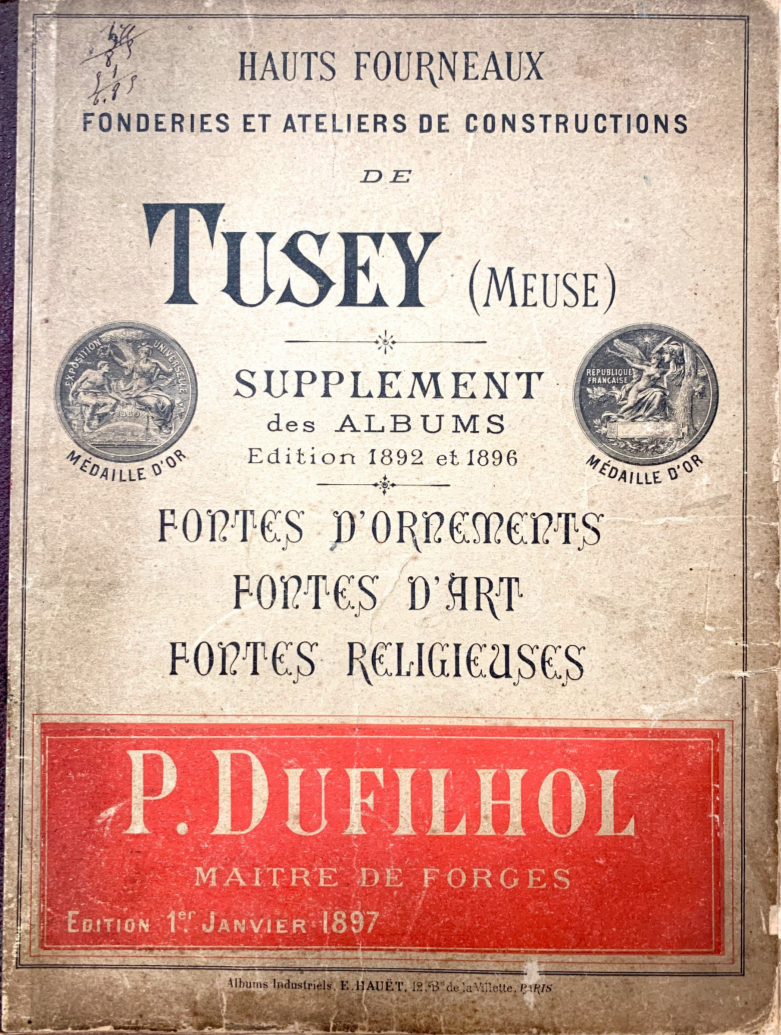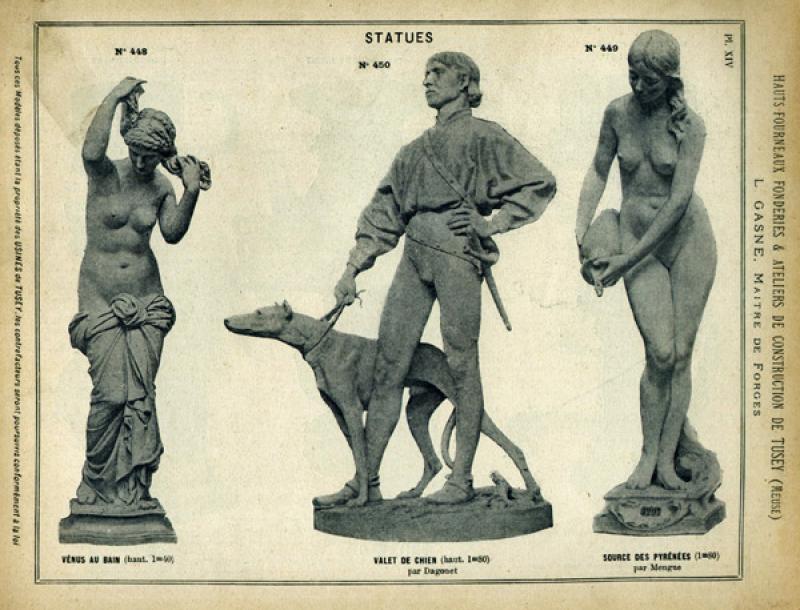Named after their geografic origin, the Thusey foundries were located near Vaucouleurs, in the Meuse region. The many successive owners would have at heart to mark the company with their passing, while keeping a sform of esthetic and historic continuity.
In a publication dated of April, the first 1897, the foundries and building workshops of Tusey describe, by a notice, the historic of the establishment in these words :
« Created by Mr. Muel, developped later by MM. Wahl, Zégut and Gasne, the factories of Tusey were, in France, the creators of the Industrie des Fontes d’art et d’ornement, which they have contributed to improve and spread.
Thanks to the very important models collection of all kinds they owe, their spreading, organization and tools, they are able to satisfy all the orders that would have been made and to prepare and execute all projects that would have been asked. »
Muel, the foundries founder, who owned a shop on the rue Aumaire (today rue au Maire) in the 3rd district of Paris, receives the spectacular order of two fountains and sixteen commemorative columns to adorn the place de la Concorde. This prestigious order insures the reknown and recognition of the foundries, which affirms its place on the art bronzes on the border between fine Arts and industry.
Louis Gasne, the last master of the foundries before the arrival of Chapal and Dufilhol, had, by being interested in the lost wax foundry and praticing it in parallel of his industrial activities, given to the most famous foundries of the Meuse region, an artistic orientation that his successors will try to keep on. Moreover we notice that in 1897, the three axis developped by the Tusey foundries in their catalogues are the art cast iron, the decorative cast irons and the religious cast iron.
From 1896 to 1898, two men are leading the tusey foundries for a short time : Gaston Chapal, who is called by his father from 1898 to take the direction of the family company, the foundries and workshops of Kerloc (Auray), and leaves to P. Dufilhol the direction of the Tusey foundries. .
With Dufilhol, the foundries present to the World’s Fair of 1900 a cast iron dog valet Valet by Dagonet, with urban furniture and decoratives pieces.
A reversal of fortune happened in 1904, when Dufilhol i sbankrupt. Laurent Chevaillier, takes the foundries after 1904, ans will support the war effort during the first World War by producing grenades for France, but quickly, the armistice, around 1920, interupts definitively the art cast iron in Tusey to be concentrated only on the production of funeral monuments.
After his death, the foundries keep their activity until 1935, date a new bankruptcy under the appelation « Les Héritiers de L. Chevallier ». The study of a catalogue from 1925 confirms the end of the interest for the art cast irons for an activity of mainly locksmiting.
The last master of the foundries, Pierre Esch, for the favor of a fusion with the Société anonyme des Ateliers et Fonderies de la Meuse (old Jeanne d’Arc Foundry), changes the name of the company for Vaucouleurs Foundries in 1961. The year 1963 marks the abondonment of the historical site of the Tusey, as the set of mecanical foundries are then concentrated in Vaucouleurs.
The models from the Tusey foundries production, bought by Capitain-Géry and Salin, two masters of the foundries, find a legacy on the creations of the last heirs of the Tusey foundries.
Discover our other websites
dedicated to houses and artists from the second half of the 19th century
Théodore Deck
L'Escalier de Cristal
Fourdinois
Gentil & Bourdet
Victor Geoffroy-Dechaume
Henri Husson
Alfred Janniot
Jules Loebnitz
Paul Sédille
Perret & Vibert
J-Nicolas Rivart
Gabriel Viardot
Find us
120 rue des Rosiers 93400

+33 (0)6 60 62 61 90

contact@marcmaison.com

Copyright © Marc Maison | 2021
Privacy politic






